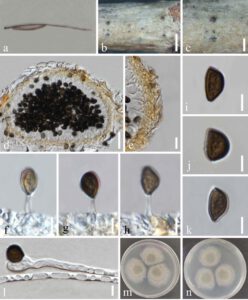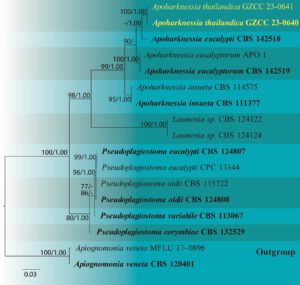Apoharknessia thailandica N. Wu, Jian K. Liu & K.D. Hyde, sp. nov.
Index Fungorum number: IF 900618; Facesoffungi number: FoF 14373; Fig. 1
Etymology – Name refers to the country where this fungus was collected, Thailand.
Holotype – GZAAS 23-0645
Saprobic on decaying branches of an unidentified host, forming black spots on the host surface. Asexual morph: Conidiomata 110–150 × 110–160 μm (x̄ = 140 × 130 μm, n = 10), semi-immersed or immersed in the substrate, solitary, globose to subglobose, dark brown, composed of thin-walled cells of textura angularis, unilocular, glabrous. Peridium up to 6–12 μm wide, consisting of yellow and small textura angularis cells. Conidiophores micronematous, reduced to conidiogenous cells. Conidiogenous cells 5–8 × 1–2 μm, lageniform to ampulliform or ampulliform to subcylindrical, hyaline, smooth, percurrently proliferating once or twice near the apex. Conidia 9–12 × 6–8 µm (x̄ = 10 × 7 µm, n = 30), broadly ellipsoidal to obovoid or obliquely gibbose, apex obtusely rounded, aseptate, non-apiculate, medium brown or brown, with or without a longitudinal hyaline band on flat surface, thick-walled, smooth, with or without striations along the length of conidia, with prominent central guttules, basal and apical appendage absent. Sexual morph: Undetermined.
Material examined – Thailand, Chiang Mai Province, Mae Taeng District, Ki Lek Sub-district, Chang Wat, 19°07’08.3”N, 98°44’03.2”E, on an unidentified dead wood, 10 August 2019, Na Wu, YW148 (GZAAS 23-0645, holotype), ex-type living culture GZCC 23-0640; ibid., Cho Lae Sub-district, Chang Wat, 19°08’01.3”N, 99°00’29.4”E, on unidentified leaf, 6 August 2019, Na Wu, YW179 (GZAAS 23-0646), living culture GZCC 23-0641.
Culture characteristics – Conidia germinating on PDA within 12 h. Colonies are slow-growing, reaching 45 mm diam. after one week at 20–23 °C, with moderate aerial mycelium and smooth, lobate margins, greenish-black in the middle, dirty white in the outer region.
GenBank accession numbers – GZCC 23-0640 – LSU: OR147191, ITS: OR147194; GZCC 23-0641 – LSU: OR147192, ITS: OR147195.
Notes – In our phylogeny, we included all species of Apoharknessia that have molecular data in the GenBank. Phylogenetically recognized, A. thailandica is closely related to A. eucalypti but forms a distinct linage (Fig. 47). Morphologically, the conidia of A. thailandica (9–12 × 6–8 µm) are larger than the conidia of A. eucalypti ((7–)8–10(–11) × (5–) 6(–7) μm) (Marin-Felix et al. 2019). In addition, the conidia of A. thailandica do not have any basal or apical appendages. In terms of the nucleotide comparison, A. thailandica and A. eucalypti differed in twenty base pairs in the ITS region and three in the LSU region. Therefore, we establish our strain as a novel species in Apoharknessia.

Fig. 1 – Apoharknessia thailandica (GZAAS 23-0645, holotype). a–c Conidiomata on the host substrate. d Cross section of a conidioma. e Peridium. f–h Conidiophores and conidia. i–k Conidia. l Germinating conidium. m, n Colonies on the PDA from above (m) and below (n). Scale bars: b = 50 μm, c, d = 20 μm, e–l = 5 μm.

Figure 2 — Phylogram generated from maximum likelihood analysis based on combined LSU and ITS sequence data representing the species of Diaporthales. Seventeen taxa were included in the combined analyses, which comprised 1514 characters (ITS = 664 bp, LSU = 850 bp) after alignment. The best-scoring RAxML tree with a final likelihood value of -4419.572824 is presented. The matrix had 274 distinct alignment patterns, with 15.77% of undetermined characters or gaps. Bootstrap support values for maximum likelihood (ML) equal to or greater than 75% and Bayesian posterior probabilities (BYPP) equal to or greater than 0.95 are indicated above or below the nodes. The newly generated sequence is indicated in yellow. The tree is rooted to Apiognomonia veneta (MFLU 17-0896 and CBS 120401). The ex-type strains are indicated in bold.
